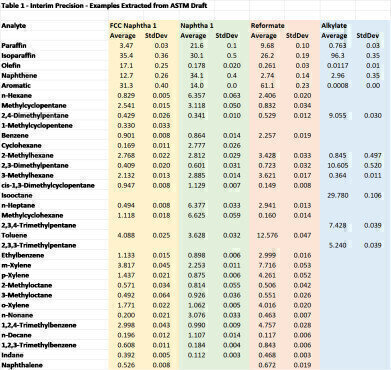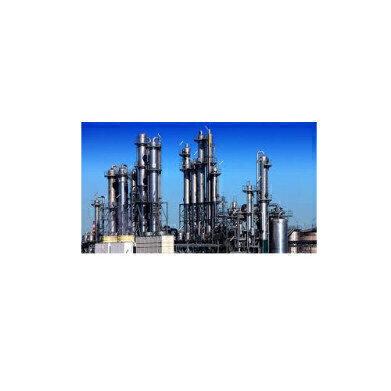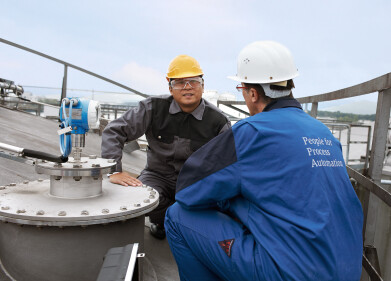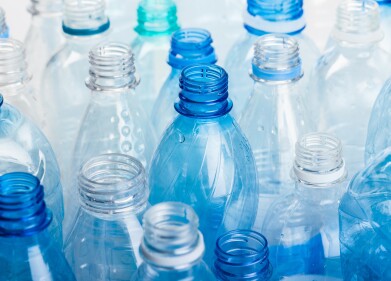-
.jpg)
-
 Note – Complete Interim Precision Study is included in the ASTM Draft. Each sample was run on one instrument 14 times under repeatability conditions.
Note – Complete Interim Precision Study is included in the ASTM Draft. Each sample was run on one instrument 14 times under repeatability conditions. -

Analytical Instrumentation
Refinery Optimisation with Confidence in Data Quality
Jul 21 2020
This article provides an update of the Standard Test Method for Detailed Hydrocarbon Analysis by High Resolution Gas Chromatography with Vacuum Ultraviolet Absorption Spectroscopy (GC-VUV) in the ASTM process and its greatest applicability (WK 64297).
The draft ASTM method first mentions that it is applicable to “typical products encountered in petroleum refining or biofuel operations, such as blend stocks; naphthas, reformates, alkylates, FCC gasoline, liquefied petroleum gas (LPG)…”, and then the scope states that “spark-ignition engine fuels…” can also be analysed. Referencing refinery streams before spark-ignition engine fuels (i.e. gasoline) is intentional. The greatest advantage of Verified Hydrocarbon Analysis™ (VHA) is to refinery streams.
DHA by GC-FID is very common in refinery labs. The chemist is somewhat free to choose modifications to ASTM methods D6729 and D6730. These deviations may be to the carrier gas (e.g. hydrogen), oven temperature profile or the column (e.g. high speed, high resolution microbore columns). A common method modification is the use of sample templates or reference chromatograms.
Using customised templates improves the accuracy and efficiency of the DHA analysis. The chemist chooses the right template for the sample and then goes through the tedious process of properly integrating the chromatogram, matching all the sample peaks to the reference template for that particular stream.
The VHA analyst begins with the same process; choosing analytical parameters that are most suitable to their site and then matching a template or spectral library specific to the refinery stream of interest. After this, VHA begins to shine and the advantages become clear. There is a significant GC run time savings of up to 90 minutes. Additionally, the automated data analysis saves chemists’ time, meaning that the refinery chemist can provide the engineering group much faster turnaround times with more reliable data. VHA eliminates common DHA component misidentifications, reduces unknowns to zero and provides better precision (Table 1 Interim Precision - Examples Extracted from ASTM Draft).
The bigger picture is refinery optimisation. Refinery blending streams are ultimately components final products. Blend targets of these final products can be optimised using lower-cost streams when there is confidence in data quality. Better precision of the components matter. The return on investment of VUV technology is quickly realised by taking advantage of blend stream price differences. ROI is also realised on refinery unit optimisation. Reformer performance and the resulting octane number of the reformate is a function of the feed naphtha properties, with higher naphthene and aromatic content being more desirable. Forward thinking refiners are already employing on-line VHA, matching laboratory capabilities to optimise operations.
If both DHA and VHA methods are routinely modified, then why is an ASTM method important? The ASTM method provides legitimacy, defines product types and components that can be analysed, concentration ranges of the components, provides starting analytical conditions, specifies necessary materials and equipment and indicates the expected precision of the analysis. The GC-VUV method is in the balloting process at the D02.04 subcommittee level. I expect the method to be published this year.
By: Dan Wispinski, Standard Methods Development Manager, VUV Analytics
Digital Edition
PIN 25.1 Feb/March
March 2024
In This Edition Safety - The technology behind the ION Science Tiger XT - Safety with ammonia and LOHCs as hydrogen carriers Analytical Instrumentation - Discussion on new tribology te...
View all digital editions
Events
Apr 22 2024 Hannover, Germany
Apr 22 2024 Marrakech, Morroco
Apr 22 2024 Muscat, Oman
Apr 22 2024 Rotterdam, Netherlands
Apr 23 2024 Singapore

















